Dynamic Stability of Axially Accelerating Viscoelastic Plate
Abstract
The transverse vibration of an axially accelerating viscoelastic plate is investigated. The governing equation is derived from the two-dimensional viscoelastic differential constitutive relation while the resulting equation is discretized by the differential quadrature method (DQM). By introducing state vector, the first-order state equation with periodic coefficients is established and then it is solved by Runge-Kutta method. Based on the Floquet theory, the dynamic instability regions and dynamic stability regions for the accelerating plate are determined and the effects of the system parameters on dynamic stability of the plate are discussed.
1. Introduction
Transmission belts, band saw blades, elevator cables, magnetic types, paper webs are some technological examples of axially moving continua. There are comprehensive studies on such systems [1–5]. In recent years, much attention has been paid to parametric vibration of traveling systems and transverse parametric vibration of axially accelerating systems has been extensively analyzed [6, 7]. Pakdemirli et al. [8] conducted a stability analysis using the Floquet theory for sinusoidal transporting velocity function. Oz [9] used the method of multiple scales to calculate analytically the stability boundaries of an axially moving beam with the velocity as a simple harmonic function. Based on the second-term Galerkin discretization, Chen et al. [10] analyzed the stability of axially accelerating linear beams. Chen and Yang [11] studied transverse stability of axially moving viscoelastic beams with the speed that is harmonically fluctuating about a constant mean value.
All above-mentioned researchers considered elastic beams or viscoelastic strings and viscoelastic beams; however, the literature that is specially related to axially accelerating viscoelastic plates is relatively limited. To address the lack of research in this aspect, the present investigation is devoted to analytical study of axially accelerating viscoelastic plate.
In this paper, we take the axially accelerating viscoelastic plate as research object; the axially moving speed of the plate is a constant mean speed with small harmonic variations. The partial differential equation of motion was discretized by DQM, then the stability analysis was made using the Floquet theory and effects of the system parameters on dynamic stability of the plate are discussed.
2. The Governing Equation
Consider a uniform axially moving viscoelastic plate, with density ρ, the length a, width b, and thickness h in the x, y, and z directions, respectively. The plate move with the time-dependent axial speed v(t), as shown in Figure 1.
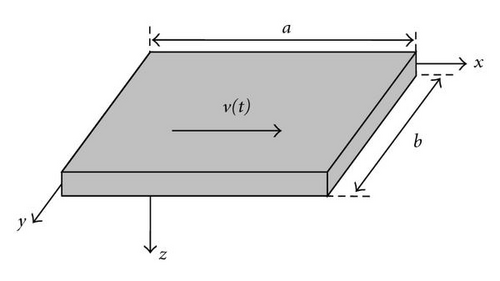
The speed in the x direction is assumed to be a small simple harmonic variation about the constant mean speed, namely, v(t) = v0 + v1sinωt.
3. Discretization of the Governing Equation by Differential Quadrature Method
4. Dynamic Stability Analysis
It is known from the analysis mentioned above that the eigenvalues of the dynamic stability equation must be calculated before determining the dynamic instability region.
We can use initial condition U(0) = I to calculate the basic solution of (25) in a vibrational periodic. From (26), one can get A = U(τ), then solving (29), the eigenvalues are obtained. We can adopt the Runge-Kutta method to get the matrix A.
5. Results and Discussion
Numerical examples are presented to examine the effects of the dimensionless delay time, the aspect ratio, and the mean axial speed on the instability region.
5.1. The Plate with Four Edges Simply Supported (ssss)
Figure 2 shows the effect of the dimensionless delay time for ϕ = 1, c = 2, and H = 10−4 (dotted line), 10−3 (solid line). Obviously, the larger the dimensionless delay time, the smaller the instability region.
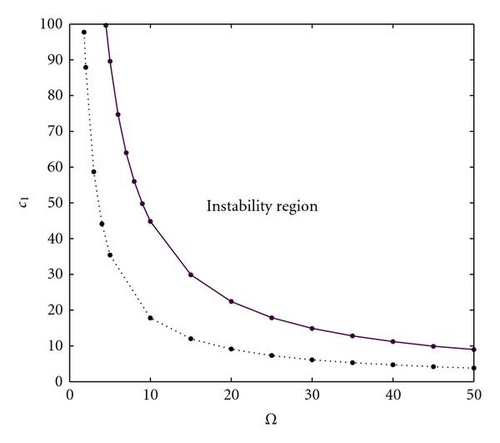
Figure 3 depicts the effect of the aspect ratio for H = 10−3, c = 2, and ϕ = 0.5 (dashed line), 1 (solid line). It indicates that with the increase of aspect ratio, the instability region decreases.
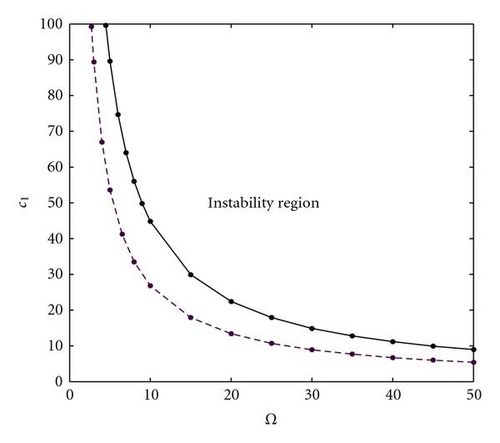
Figure 4 illustrates the effect of the mean axial speed for H = 10−3, ϕ = 1, and c = 2 (solid line), 5 (dash-dotted line).It can be seen that the larger the mean axial speed, the smaller the stable region.
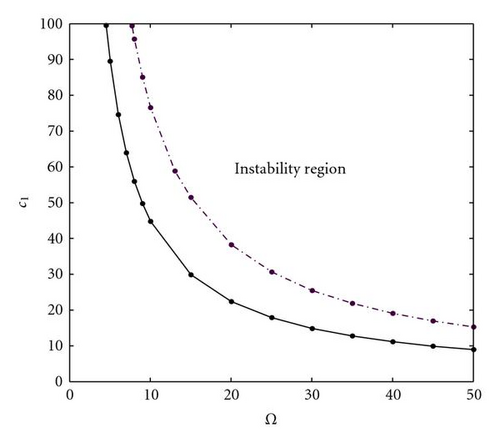
5.2. The Plate with Two Opposite Edges Simply Supported and Other Two Edges Clamped (cscs)
Figures 5, 6, and 7 demonstrate, respectively, the effects of the dimensionless delay time, the aspect ratio, and the mean axial speed on the instability region for the plate with two opposite edges simply supported and other two edges clamped. In Figure 5, ϕ = 1, c = 2, and H = 10−4 (dotted line), 10−3 (solid line). In Figure 6, H = 10−3, c = 2, and ϕ = 0.5 (dashed line), 1 (solid line). In Figure 7, H = 10−3, ϕ = 1, and c = 2 (solid line), 5 (dash-dotted line). Similar to the trends for the plate with four edges simply supported, the larger the dimensionless delay time, the larger the aspect ratio and the smaller the mean axial speed, which lead to the smaller the instability region. That is, the increasing dimensionless delay time, the increasing aspect ratio, and the decreasing mean axial speed make the instability boundaries move toward the increasing direction of c1 in plane (Ω, c1) and the instability regions become small.
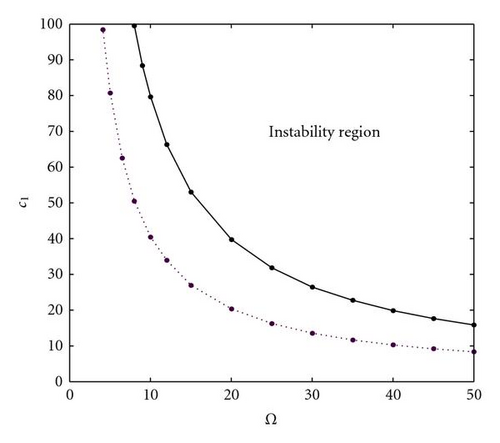

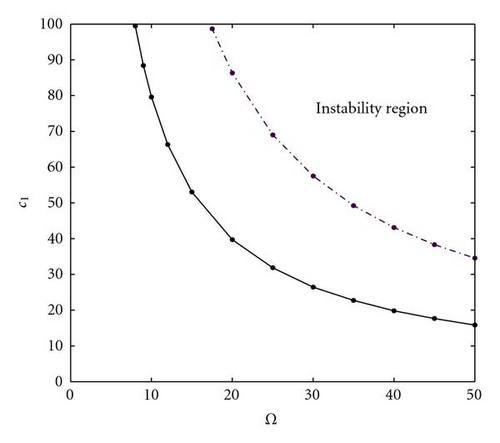
6. Conclusions
Dynamic stability of axially moving viscoelastic plate is studied in this paper. The axially moving speed of the viscoelastic plate is assumed as harmonically fluctuating about a constant mean value. The differential quadrature method is applied to the partial-differential equation governing the transverse parametric vibration.
The results of the present investigation indicate that, for the SSSS plate and the CSCS plate considered in the paper, (1) with the increase of the delay time H, the instability region decreases, (2) with the increase of the aspect ratio ϕ, the stability region decreases, (3) with the increase of the mean axial speed c, the instability region increases. In addition, for the same parameters, the instability region of CSCS plate is smaller than that of SSSS plate.
Acknowledgment
The research is supported by the National Natural Science Foundation of China (Project no. 10872163).




